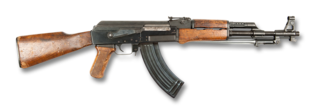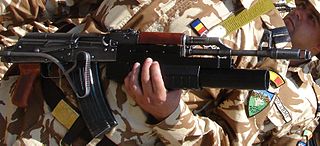
The IMI Galil is a family of Israeli-made automatic rifles chambered for the 5.56×45mm NATO and 7.62×51mm NATO cartridges. Originally designed by Yisrael Galili and Yakov Lior in the late 1960s, the Galil was first produced by the state-owned Israel Military Industries and is now exported by the privatized Israel Weapon Industries.

The RK 62, officially 7.62 RK 62 and commercially M62, is an assault rifle manufactured by Valmet and Sako. It is the standard issue infantry weapon of the Finnish Defence Forces.

The Vektor R4 is a 5.56×45mm assault rifle designed in 1979 based on the IMI Galil rifle. It entered service as the standard service rifle of the South African Defence Force (SADF) in 1980. The R4 replaced the R1, a variant of the 7.62×51mm FN FAL. It was produced by Lyttelton Engineering Works, now Denel Land Systems.

The PP-19 Bizon is a 9×18mm Makarov submachine gun developed in 1993 by the Russian company Izhmash. The Bizon was designed by a team of engineers headed by Victor Kalashnikov and including Alexei Dragunov.

The Type 56 also known as AK-56, is a Chinese 7.62×39mm rifle. It is a variant of the Soviet-designed AK-47 and AKM rifles. The Type 56 rifle was designated by the Chinese military as "Type 1956 Sub-Machinegun", because the Type 56 took the role of SMG rather than infantry service rifle in the PLA in the rifle's early service years. Production started in 1956 at State Factory 66 but was eventually handed over to Norinco and PolyTech, who continue to manufacture the rifle primarily for export.
The RPK, sometimes retroactively termed the RPK-47, is a Soviet 7.62×39mm light machine gun that was developed by Mikhail Kalashnikov in the early 1960s, in parallel with the AKM assault rifle. It was created to standardize the small arms inventory of the Soviet Army, where it replaced the 7.62×39mm RPD machine gun. The RPK continues to be used by the military of the post-Soviet states and certain African and Asian nations. The RPK is also manufactured in Bulgaria, Romania, and Serbia.
The karabinek wzór 1988 Tantal is a 5.45×39mm assault rifle designed and produced in Poland in the late 1980s.
The RK 95 TP, officially 7.62 RK 95 TP and commercially known as the M95, is a 7.62×39mm Finnish assault rifle adopted in relatively small numbers by the Finnish Defence Forces in the 1990s. The RK 95 TP originally featured many improvements including a fire control selector and a muzzle device that enabled the firing of rifle grenades, the attachment of a suppressor, or bayonet. The rifle is only used by Finland.

The AS Val,, is a special assault rifle similar to the VSS.
The Model L is a Spanish 5.56×45mm NATO assault rifle developed in the late 1970s at the state-owned small arms research and development establishment CETME located in Madrid. The rifle retains many of the proven design elements the institute had used previously in its CETME Model 58 battle rifles.
The Zastava M70 is a 7.62x39mm assault rifle. Developed in Yugoslavia by Zastava Arms during the 1960s, the M70 was an unlicensed derivative of the Soviet AK-47. It became the standard issue infantry weapon in the Yugoslav People's Army in 1970, complementing and later superseding the Zastava M59/66. Both the original M70 design, as well as commercial variants of the weapon without select-fire capability, known as the Zastava PAP series, were still produced by Zastava for export up until July 15th 2023. Serbia has now put an export ban in place for rifles.

The AKM is an assault rifle designed by Soviet small arms designer Mikhail Kalashnikov in 1959. It was developed as a replacement to the AK-47 introduced a decade prior.

The KK 62, officially 7.62 KK 62 and colloquially KVKK or KVKK 62, is a Finnish 7.62×39mm light machine gun designed in late 1950s with the first prototype ready for testing in 1960. It was officially adopted as the standard infantry support weapon of the Finnish Defence Forces (FDF) in 1962 as the 7.62 konekivääri 62; the first weapons were delivered in 1966. It remains in service, although a replacement has already entered use, namely the PKM general-purpose machine gun.

A Kalashnikov rifle is any one of a series of automatic rifles based on the original design of Mikhail Kalashnikov. They are officially known in Russian as "Avtomát Kaláshnikova", but are widely known as Kalashnikovs, AKs, or in Russian slang, a "Kalash". They were originally manufactured in the Soviet Union, primarily by Kalashnikov Concern, formerly Izhmash, but these rifles and their variants are now manufactured in many other countries. The Kalashnikov is one of the most widely used guns in the world, with an estimated 72 million rifles in global circulation.

The Pușcă Automată model 1986 is the standard assault rifle used by the Romanian Military Forces and manufactured in Cugir, Romania by the ROMARM firm, located in Bucharest. The export name for this variant is the AIMS-74.
The AK-12, "Avtomat Kalashnikova, 2012" is a Russian assault rifle chambered in 5.45×39mm designed and manufactured by the Kalashnikov Concern, making it the fifth generation of Kalashnikov rifles.

The FFV 890 was a Swedish assault rifle manufactured and designed by Försvarets Fabriksverk. The FFV 890 was based on the Israeli IMI Galil through a manufacturing licence, which in turn was based on the Finnish Valmet RK 62 and ultimately the Soviet AK-47. The FFV 890 was designed between 1975 and 1980, and its final iteration, FFV 890C, competed in the Swedish Armed Forces trials for the new 5.56×45mm NATO assault rifle, where it ended up as a runner-up to the FN FNC, which was then chosen as the Ak 5. The FFV 890C was never widely adopted by any service, though some rifles were used by the Swedish police.

The Valmet Sniper M86 is a Finnish sniper rifle designed by the former Finnish state firearms company Valmet. The rifle was Valmet's first and only proper sniper rifle, and after the merger with Sako in 1986, its development work was the basis for the Sako TRG sniper rifles. The rifle was produced only in small numbers in 1987 due to the merger.
The STV, short for Súng Trường Việt Nam or Súng Tiểu liên Việt Nam, is a family of Vietnamese assault rifles. They are products of the Z111 Factory and are chambered in 7.62x39mm.
The Sako M23 is a Finnish family of assault and battle rifles designed by Sako in cooperation with the Finnish Defence Forces and manufactured by Sako. The Swedish Armed Forces also participated in the development program for the M23.














